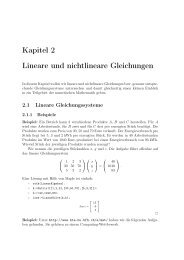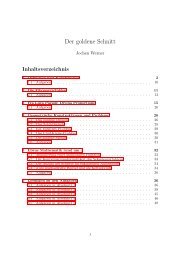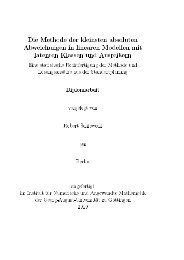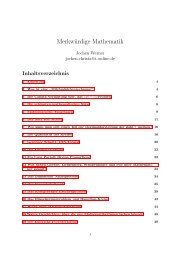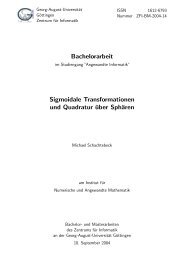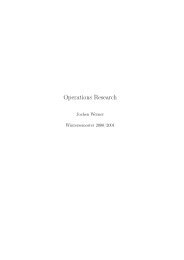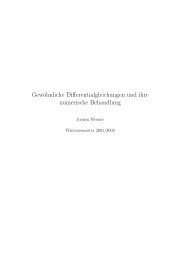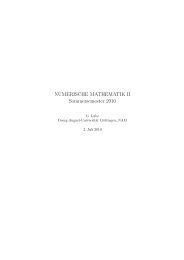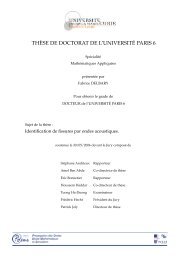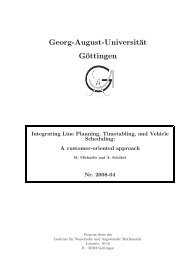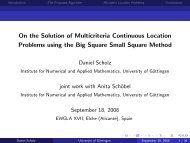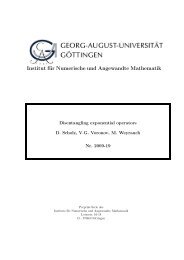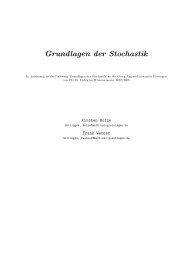BAIL 2006 Book of Abstracts - Institut für Numerische und ...
BAIL 2006 Book of Abstracts - Institut für Numerische und ...
BAIL 2006 Book of Abstracts - Institut für Numerische und ...
You also want an ePaper? Increase the reach of your titles
YUMPU automatically turns print PDFs into web optimized ePapers that Google loves.
M. BAUSE: Aspects <strong>of</strong> SUPG/PSPG and GRAD-DIV Stabilized Finite Element<br />
Approximation <strong>of</strong> Compressible Viscous Flow<br />
✬<br />
✫<br />
Aspects <strong>of</strong> SUPG/PSPG and GRAD-DIV Stabilized<br />
Finite Element Approximation <strong>of</strong> Compressible Viscous Flow<br />
Markus Bause<br />
<strong>Institut</strong> <strong>für</strong> Angewandte Mathematik, Universität Erlangen-Nürnberg<br />
Martensstr. 3, 91058 Erlangen<br />
bause@am.uni-erlangen.de<br />
In this contribution various aspects <strong>of</strong> a theoretical analysis and numerical study <strong>of</strong><br />
SUPG/PSPG and grad-div stabilized finite element approximations (cf. [3]) <strong>of</strong> steady<br />
and unsteady compressible isothermal viscous flow are addressed. After temporal discretization<br />
<strong>of</strong> the time variable by means <strong>of</strong> the implicit Euler method, the equations <strong>of</strong><br />
compressible viscous flow are solved by an iteration between a generalized Oseen problem<br />
for the velocity and a hyperbolic transport equation for the perturbation from the mean<br />
density (cf. [1]). Such a splitting-type approach seems attractive for computations because<br />
it <strong>of</strong>fers a reduction to simpler problems for which highly refined numerical methods either<br />
are known or can be built from existing discretization techniques for similar equations,<br />
and because <strong>of</strong> the guidance that can be drawn from an existence theory based on it.<br />
In the case <strong>of</strong> steady motions <strong>of</strong> a compressible viscous gas, decribed by the equations<br />
∇ · (ρv) = 0 , ρv · ∇v − µ∆v − (λ + µ)∇∇ · v + ∇p = ρf ,<br />
p = kρ , v|∂Ω = 0 ,<br />
�<br />
Ω ρ dx = M<br />
the iteration for solving this system reads as: Let ρ = 1 + σ. Put v0 = 0, σ0 = 0. For<br />
given vn, σn compute vn+1, σn+1 by<br />
(i) solving the generalized Oseen-system<br />
∇ · vn+1 = −∇ · (σnvn) ,<br />
(1 + σn)vn · ∇vn+1 + 1<br />
2 ∇ · ((1 + σn)vn)vn+1 − µ∆vn+1 + ∇πn+1 = (1 + σn)f ,<br />
vn+1|∂Ω = 0,<br />
�<br />
Ω πn+1 dx = 0<br />
(ii) and, then, solving the hyperbolic transport equation<br />
kσn+1 + (λ + 2µ)∇ · (σn+1vn+1) = πn+1 − µ∇ · vn+1 .<br />
For the approximation <strong>of</strong> the separated Oseen problem, SUPG/PSPG and grad-div stabilized<br />
higher order finite techniques based on LBB-stable elements are used and analyzed.<br />
The transport equation is discretized by SUPG stabilized finite element methods. Error<br />
estimates are provided. Numerical results for realistic steady and unsteady benchmark<br />
problems (driven cavity flow, flow over a backward facing step and DFG-benchmark) are<br />
given for a large scale <strong>of</strong> Reynolds numbers.<br />
References<br />
[1] M. Bause, J. G. Heywood, A. Novotny and M. Padula, On some approximation schemes<br />
for steady compressible viscous flow, J. Math. Fluid Mech., 5 (2003), pp. 201–230.<br />
[2] M. Bause, Stabilized finite element approximation <strong>of</strong> compressible viscous flow, to appear, <strong>2006</strong>.<br />
[3] T. Gelhard et al., Stabilized finite element schemes with LBB-stable elements for incompressible<br />
flow, J. Comput. Appl. Math. 177 (2005), pp. 243–267.<br />
Speaker: BAUSE, M. 72 <strong>BAIL</strong> <strong>2006</strong><br />
✩<br />
✪



